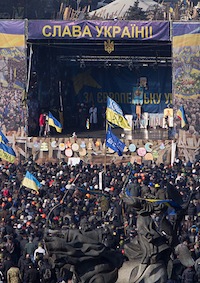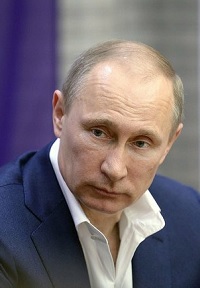Europe: How to Stabilize Ukraine
Focusing on three things – jobs, trade and free travel – can work wonders.
March 24, 2014

Having finally mastered the euro crisis, Europe faces a big new challenge: how to stabilize Ukraine. Much is at stake. A stabilized Ukraine would advance peace, prosperity and the rule of law across a major swath of Europe.
In sharp contrast, a weak and crisis-ridden Ukraine would invite Putin to stoke violent unrest and possibly start a war. That would have disastrous consequences, not just for Russia and Ukraine but also for Europe as a whole.
Europe has powerful tools to stabilize Ukraine. It can offer three things – access, money and advice. As a quick rule of thumb, Europe needs to minimize the pain and maximize the upfront gains to be felt across Ukraine. This applies especially for strategically contested Eastern Ukraine.
Access: Trade, travel and jobs
The European Union is the world’s biggest single market and one of the most attractive places to work in the world. Offering access to itself is the EU’s trump card.
Trade: The envisaged fast-track abolition of virtually all tariffs on Ukrainian exports to the EU is an excellent start. If that is worth up to €500 million per year for Ukraine, as the EU claims, it would make a difference. Still, that would amount to just 0.4% of Ukrainian GDP. Europe needs to go far beyond that and soon.
Travel: Visa-free travel to the EU is one of the benefits of belonging to Europe most coveted by those outside. The psychological impact of granting Ukrainians visa-free entry to the EU (or at least the Schengen area) could be significant.
Jobs: Most important, the EU could grant Ukrainians the right to work freely in the EU, putting Ukraine on par with accession countries such as Poland.
This one step would bring the EU and Ukraine much closer. It would be a major safety valve for the Ukrainian labor market at a time of change. And remittances could be a significant stabilizer for Ukrainian living standards. The free movement of labor would strengthen ties between the EU and Ukraine in a myriad of small ways and help Ukraine transform itself over time.
Education: As a subset of facilitating travel, students from Ukraine must be enabled to study abroad in Europe more easily. Studying abroad broadens horizons. The EU should offer Ukraine an Erasmus program of student interchange writ large.
Getting a coalminer’s daughter from Donetsk, in Eastern Ukraine, to study a year in Paris could do wonders to strengthen pro-European sentiment back home. Moscow just isn’t a match for Paris or Barcelona.
In enhancing and advancing its association agreement with Ukraine, the EU needs to take one precaution, though. The economic parts of the agreement with Ukraine should not impose obligations on Ukraine which could artificially disrupt Ukrainian exports to Russia. 25% of Ukrainian exports go there.
Money: Modest amounts go a long way
Ukraine is a sizeable country with 44 million people. But because it has been badly mismanaged, its economy remains small. With a GDP of roughly 1.4% of that of the Eurozone, Ukraine trails Portugal and Ireland.
Modest amounts of money, probably well below the €30-35 billion which Russia reportedly wasted on Sochi, could go a long way in Ukraine. As part of a comprehensive Western support program, an orderly default on some Ukrainian legacy debt need not be a political taboo, including possibly on legacy debt held by Russian institutions.
Advice: Reforms rather than austerity
Support for Ukraine needs to be generous and conditional. But the conditions have to be set wisely. One of the worst mistakes Europe could make would be to impose a standard IMF-style austerity program on Ukraine.
First, Ukraine needs institutional reforms, a clampdown on corruption and a focus on the general rule of law much more than any macroeconomic adjustment.
Second, Ukraine’s political situation is far too fragile to impose years of Portuguese-style or even Greek-style fiscal pain on the country before the gains finally become visible, as they now do in Portugal and – to some extent – in Greece.
Years of mass unemployment in Donetsk are not what Europe needs to keep the situation calm. At least in addition to the macroeconomic experts of the EU/ECB/IMF troika, Europe should send the architects of the outstandingly successful Estonian and Slovakian post-Soviet reforms to Kiev, backed up by OECD deregulation experts.
After years of corrupt mismanagement at the top, Ukrainian institutions are weak and inefficient. To the extent that Europe and the IMF can help to shape rules and institutions in the new Ukraine, the focus should be on simple rules that are easy to administer.
■ Simple rules are often more efficient. More important, they offer less scope for corruption even if, in their simplicity, they may not do justice to all special cases. A flat tax along the initial Slovakian lines is just one example.
■ Part of the structural reforms ought to be the opening up of monopolies.
■ To discourage the wholesale waste of energy, mostly imported from Russia, prices for gas may need to rise in Ukraine. But the focus should be on getting incentives right more than on plugging a fiscal hole. The socially vulnerable majority of those hurt by costlier heating should be compensated by targeted direct subsidies or offsetting tax cuts.
Ukraine has macroeconomic imbalances. Its current account deficit amounts to 6.8%, the fiscal deficit stands at 5.2% and public debt is 41% of GDP (2013 estimates). But with access to Europe, pro-growth structural reforms and a better incentive structure, these imbalances can narrow over time without drastic upfront austerity.
Under an ever more autocratic Putin, Russia’s fragile petro economy is on a gradual but inexorable decline unless an unexpected surge in raw material prices were to interrupt the process for a while. Over time, Russia will look ever less attractive to those Ukrainians who may still be torn between Putin and Europe.
The challenge for the EU is to manage the Ukrainian transition in a way that more and more Ukrainians feel the benefits of joining the European mainstream fast.
Putin could win any military confrontation on the ground easily for now. But if Europe plays its trump cards wisely, it can and will win the competition for hearts and minds, which ultimately matters much more.
In the end, the example of a Ukraine that gradually turns itself into a Polish-style success story could set an inspiring example for those many Russians who – like their Ukrainian counterparts – yearn for the free and prosperous life under the rule of law which only Western-style democracies can offer.
Takeaways
Europe has powerful tools to stabilize Ukraine. It can offer three things – access, money and advice.
The psychological impact of granting Ukrainians visa-free entry to the EU could be significant.
The right to work freely in the EU would be a major safety valve for the Ukrainian labor market.
A coalminer's daughter from east Ukraine, studying a year in Paris would strengthen pro-European sentiment back home.
An orderly default on some Ukrainian debt need not be a political taboo, including debt held by Russian institutions.
Support for Ukraine needs to be generous and conditional. But the conditions have to be set wisely.
Years of mass unemployment in Donetsk are not what Europe needs to keep the situation calm.
Europe should send the architects of successful Estonian & Slovakian reforms to Kiev, with OECD deregulation experts.
A Ukraine that becomes a Polish-style success story could set an inspiring example for many Russians.
Read previous

Putin’s Russia Reset
March 24, 2014
